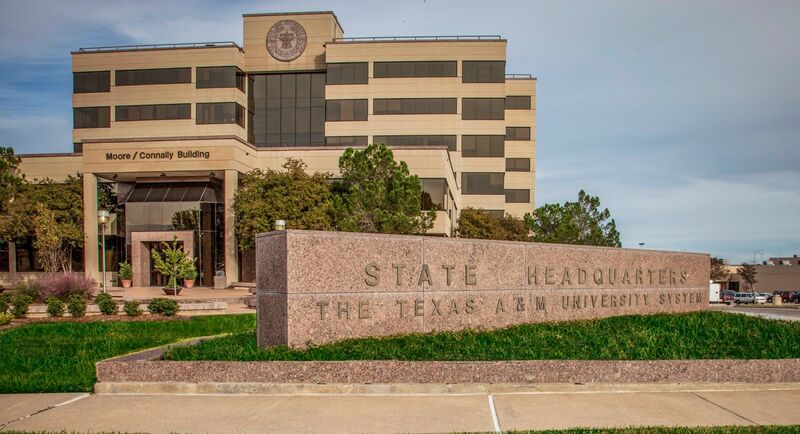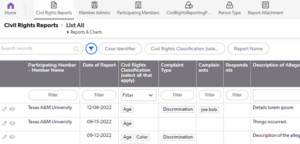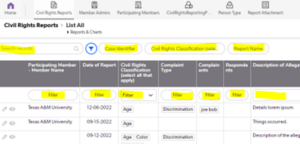Civil Rights Compliance
SECO Civil Rights
Operational Manual
Updated (DATE)
The System Ethics and Compliance Office (SECO) provides an operational manual to assist system members in their compliance with System Regulation 08.01.01. On this page, you will find a description of all steps of the complaint resolution process (and related areas), as well as all needed resources to complete tasks related to the process.
The Civil Rights Operational Manual is developed and maintained by the System Ethics and Compliance Office (SECO) for The Texas A&M University System. It is intended for System member universities and agencies (members) to apply to their processes for civil rights compliance and complaint resolution processes. This document is the property of The Texas A&M University System (A&M System) and may not be used for commercial purposes.
Please note that this document is intended to complement System Regulation 08.01.01 and aid in compliance efforts with the regulation. In the event that the regulation and this manual conflict, deference is always given to the regulation.
This manual is intended to be a “living” document and will be regularly updated by SECO. This manual is up to date with Title IX (2023 Regulations), Title VII, The Americans with Disabilities Act, The Violence Against Women Act (VAWA), and State of Texas law.
A. Reporting to SECO
1. All complaints (verbal and written) brought to the attention of a civil rights officer in the A&M System must be reported to SECO within two business days. Reports are to be submitted through the Civil Rights Reporting Portal.
a. If the complaint cites a protected class, it may constitute a civil rights violation, a violation of a member rule (student or employee), a violation of the law, or a lack of professionalism and/or ethics. All such matters are to be reported to SECO.
b. If the complaint does not involve a protected class, the case may be referred to another authority for consideration or may be submitted for closure in the event that there are no implications for infractions of rules, laws, professionalism, or ethics. These matters do not need to be reported to the reporting portal but should be documented and maintained by the member.
c. In the event that a member is uncertain as to whether or not a matter is to be reported to the portal, members are directed to contact the Director of System Equal Opportunity and Diversity or the Director of Title IX Compliance.
d. All reports must include all information requested by the portal that is available to the member. Pseudonyms are not permitted.
e. The portal should be updated whenever circumstances indicate any major development in the case.
f. Once a case is entered into the portal, an attorney from the Office of General Counsel (OGC) will be assigned to the case, and a staff member from SECO will be assigned to the case.
g. To determine whether or not a case has civil rights implications and must be reported to SECO, please consult Chart K: Reporting to SECO. Whenever an report or complaint is suggestive of a civil rights violation but does not explicitly site a protected class, the civil rights officer should seek this information prior to the determination of whether or not to report the case to SECO. In cases where a protected class is cited and the allegation is baseless, it still must be reported.
B. Reporting to the CEO
1. The Title IX Coordinator and/or Equal Opportunity Officer shall immediately report to the CEO an allegation of a civil rights violation if the civil rights officer has cause to believe that the safety of any person is in imminent danger as a result of the incident.
2. Not less than once every three months, the member Title IX Coordinator shall submit to the CEO a written report on all complaints of sexual harassment, sexual assault, and dating violence, domestic violence, and stalking based on sex, as well as acts of sex-based misconduct alleged to have been committed by or against a person who was a student enrolled at or an employee of the institution at the time of the incident (without personally identifying information), including information regarding:
(a) the investigation of those reports;
(b) the disposition, if any, of any disciplinary processes arising from those
reports; and
(c) the reports for which the institution determined not to initiate a disciplinary
process, if any.
C. Reporting to Law Enforcement
1. Reporters and complainants may, but cannot be required to, submit a complaint or report to any law enforcement authority. Employees receiving a complaint under this regulation may not disclose the identity of the complainant to any law enforcement authority unless expressly authorized by the complainant, when an imminent threat to health or safety may exist, or when required by law.
2. Civil Rights officers should never be the source of information for the police department, other than what is necessary to fulfill reporting requirements under the Clery Act. Exceptions to this would include when a party presents a foreseeable risk of imminent violence or when required by law, as in the case of elderly, disabled, or child abuse.
a. When a civil rights officer knows that a report has been filed with the campus police and the complainant is pursuing a civil rights complaint, the civil rights officer should let the student know that the civil rights office will work in consultation with the police department to share information and develop the case.
b. When a civil rights officer knows that a report has been filed with municipal police and the complainant is pursuing a civil rights complaint, the civil rights officer should let the student know that the student may wish to file a written request with the police department asking them to share any information they collect with the civil rights process. It is also possible, depending on the police agency, to ask your own police department to seek whatever information might be available.
D. Law Enforcement Reporting to Civil Rights
1. Campus police are mandatory reporters under Title IX and under System Regulation 08.01.01. This means that the police, as university employees, are required to share all of the information they collect as it relates to any sex-based misconduct under our regulation.
2. Such sharing must be done directly by computer, either through Maxient or another means of delivering this information. The civil rights officer cannot be directed to visit the police department in order to receive this information.
3. In cases where there is sensitive evidence, the civil rights investigators do not need to possess such evidence (e.g., drugs, weapons, pornography, etc.) but it is sufficient for the police to author a memo describing each piece of evidence that cannot or should not be in the hands of a civil rights investigator. Contact OGC and/or SECO for additional guidance and assistance on this topic.
E. Clery Reporting
1. When a civil rights officer becomes aware of information that is reportable under the Clery Act, it must be shared accordingly. This is done through the Civil Rights Reporting Portal (See Section II).
F. THECB Reporting
Each October every member of the A&M System must file a report with the Texas Higher Education Coordinating Board, detailing employee reporting of sex-based harassment complaints and the disposition of those complaints.
Because the state only requires a very limited set of data fields, we became concerned as a system that reporting only the minimal information might lead to a negative perception of the management of those complaints that was not consistent with our practice. As a result, we have implemented a much broader set of data fields that we report on. This broadening provides more context for the work we do, and the new format was well-received by THECB.
Each August SECO will provide the new template for reporting, and will conduct an online training for people to become familiar with the reporting process as well as address any questions or concern they may have. If you have any questions about THECB reporting, please contact Rick Olshak.
Logging In
Using a web browser, simply navigate to https://tamus.quickbase.com and login with your TAMU NetId credentials.
You will be presented with a list of apps with which you have access. Simply click on the “Civil Rights Reporting App” icon in the list, or the similarly named tab in the top.
Then you should see a page that looks similar to: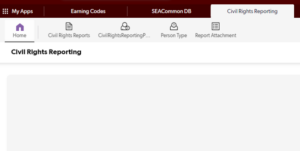
Creating a New Report
1. Click on the Civil Rights Reports icon close to the top. And it will show a list of reports in a table format. Click the button ![]() at the top right of the screen to add a new report, and you should see a window that looks like this.
at the top right of the screen to add a new report, and you should see a window that looks like this.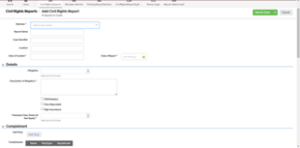
2. All of the fields marked with a red asterisk are required.
3. The list should be filtered to only the few members that you should have access to. If you need to file under a different member, please notify the Compliance Coordinator.
4. Fill out the Report Name text. This should be a short description of the case.
5. If there is a case number place in the case identifier box.
6. Fill in the location. This can be an exact address or a common location.
7. Fill in the date of the incident. This can be a specific date or an approximate description like “First quarter of 2021”.
8. Fill in the date of the report, clicking on the calendar icon can allow for quicker selection of the date.
Details Section
1. Click the Allegation dropdown and check all allegation types that apply.
2. Fill out the description of allegation field. This should be more detailed than the report name and cover the major details of the case.
3. If the parties are in STEM related departments (including staff, faculty and students), check the “STEM Related” box.
4. If the case is reportable under the Clery act, check the “Clery Reportable” checkbox. An automatic notification to the Clery Coordinator can be created and when the report is saved, an email will automatically be sent to the Clery Coordinator’s inbox with the pertinent details. Clery Coordinators will need to have access to the Civil Rights Reporting Dashboard to open the case. This checkbox can also be used to filter the cases for Title IX Coordinators to provide Clery reportable cases to the Clery Coordinator, if a notification is not desired.
5. If the case should be considered high importance (athletics, executive level staff, repeated offenses by same offender, etc), check the “High Importance” checkbox. This will trigger the case to be highlighted in yellow on the dashboard.
6. Choose all protected classes from the drop-down box that apply.
Person Files
The “Add Party” screen should look like this: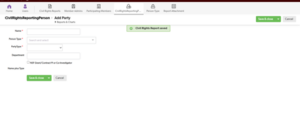
Complainant:
1. Click “Add Party”.
2. Type the Complainant Name.
3. Choose the Person Type (student, staff, faculty, third party, etc.) from the drop-down box.
4. Choose the Party Type (complainant) from the drop-down box.
5. Enter the Complainant’s department, if applicable.
a. Disregard the check box for NSF Grant/Contract PI or Co-Investigator. This applies only to respondent parties.
6. Hit “Save & Close”
Reporting Party:
1. Click “Add Party”.
2. Type the Reporting Party Name.
3. Choose the Person Type (student, staff, faculty, third party, etc.) from the drop-down box.
4. Choose the Party Type (reporter) from the drop-down box.
5. Enter the Reporting Party’s department, if applicable.
a. Disregard the check box for NSF Grant/Contract PI or Co-Investigator. This applies only to respondent parties.
6. Hit “Save & Close”
Respondent:
1. Click “Add Party”.
2. Type the Respondent Name.
3. Choose the Person Type (student, staff, faculty, third party, etc.) from the drop-down box.
4. Choose the Party Type (respondent) from the drop-down box.
5. Enter the Respondent’s department, if applicable.
a. If the respondent is a PI or Co-Investigator on a NSF Grant click the check box. This applies only to respondent parties.
6. Hit “Save & Close”
Note: Until a case is assigned to an attorney in OGC, the case will be shaded red in the system.
Resolution
1. The Initial Action drop-down box allows the Title IX Officer/Case Manager to indicate how the Civil Rights Office will be moving forward with the case. Choose the option that fits each case. For example, if moving for closure due to there being no jurisdiction over the case, choose “No Jurisdiction”. Options include
a. Closure Requested
b. Supportive Measures
c. Investigation
d. No Jurisdiction
e. Unresponsive Complainant
f. No Formal Action Requested
g. Process Complete
h. Duplicate Report
2. If requesting closure of the case input notes regarding actions taken to validate closure of the case.
3. The Preliminary Closure box is available to members that have Case Managers who are requesting closure from the Title IX Officer before requesting approval for closure from the Office of General Counsel (OGC).
4. The assigned OGC attorney will provide approval to the member by using the Resolution drop-down box.
5. The Closure Date will be filled in upon approved closure.
SECO Use Only
1. This section will be utilized by SECO and OGC to designate assignments.
Viewing
From the “Civil Rights Report Tab” you should have a default view similar to:
The results should already be limited to cases that have a member to which you are assigned. This is deliberate to help reduce the number of visible records that are not relevant to the current user.
Hovering your mouse cursor over and of the column titles, you will see 3 dots appear. Clicking on that, you can group the results by any of the columns to search for specific cases.
You can also use one of the many filtering options to show only cases that match certain criteria.
In the case that the column filter buttons are not present you can click on the blue “Filter” icon: ![]() to show the column filters.
to show the column filters.
Clicking the eye icon on the left will show the details of the record. Clicking the pencil on the left will let the user edit the particular case details.
A. Assessment for Civil Rights Jurisdiction
B. Assignment of Civil Rights Category (Type)
C. Assignment of Implicated Member Rules
D. Assessment for Supportive Measures
E. Assessment for Emergency Actions
F. Placing Employees on Leave
G. First Contact with the Complainant
H. Inquiries
I. Outcomes
- Closure
- Dismissal
- Informal Resolution
- Formal Investigation
Placeholder
A. Initiating Informal Resolution
B. Possible Outcomes
- Civil Rights
- Member Rules
- Withdrawal of Complaint
- Withdrawal from Informal Resolution Process
- Termination of Informal Resolution Process
C. Choosing the Method of Informal Resolution
D. Facilitation (and Shuttle Facilitation)
E. Mediation
F. Restorative Practices
G. Termination of Informal Resolution Process
H. Agreements
I. Outtake
A. Right to an Advisor
B. Role of the Advisor
C. Advisor Attendance
D. Communications and Information Sharing
E. Role of OGC When Attorneys Serve as Advisor
F. Member-Appointed Advisors
G. Party-Selected Advisors
H. Hearing Panel Process Advisors
A. Types of Cases
- Cases involving Allegations of Discrimination Only
- Cases involving Allegations of Sex-Based Harassment Only
- Cases involving Either #1 or #2 above and Allegations of Member Rules Violations
B. Pre-Investigation Meeting
C. Interviews
D. Interview Summaries
E. Initial Draft Report
F. Final Draft Report
G. Final Investigation Report
A. Charging Process
- Standards of Evidence
- Civil Rights
- Other System Regulations
- Member Rules
- Amnesty for Complainants, Respondents, and Witnesses
B. Adjudication of Discrimination Cases
C. Adjudication of Sex-Based Harassment Cases
Placeholder
A. Initial Notification Process
B. Department of Education (ED) Inquiries
C. Equal Employment Opportunity Commission (EEOC) Inquiries
D. Texas Workforce Commission (TWC) Inquiries
E. Other Agency Inquiries
A. Purpose of Stakeholder Groups
B. Composition of Stakeholder Groups
C. Tasks of Stakeholder Groups
A. A Guide to Understanding the Hierarchy of Laws, Regulations, Policies, and Rules
B. Job Descriptions
C. Nondiscrimination Statements
D. Syllabus Statement for Mandatory Reporting
E. Web Site Expectations
The following information must be included on member civil rights websites:
1. Name and Contact Information of Title IX Coordinator (and deputies)
2. Name and Contact Information of Equal Opportunity Officer (and deputies)
3. Nondiscrimination statements related to civil rights
4. Links to:
a. System Policy 08.01
b. System Regulation 08.01.01
c. Member Rules and/or Operational Procedures
5. Information about requesting supportive measures
6. Information on mandatory training for new students and any process for seeking exceptions
7. Information on mandatory reporting training for employees
8. Information on confidential reporters available to students and employees
9. Links to all written training materials related to System Regulation 08.01.01
10. Online reporting of civil rights complaints (with the option for anonymous reporting)
Please see 12E-1: Web Site Template for Civil Rights for sample language.
F. Q&A for Athletic Department Personnel Regarding Civil Rights Allegations and Team Discipline
The following resources have been developed to aid members in complying with the civil rights complaint resolution process. Those noted with (required) must be used “as-is” and may not be substantively altered without SECO authorization. All other documents are recommended for member use but may be modified as the member deems necessary. Resources will be regularly added and/or updated as member needs are identified. Bold type indicates an active link.
1A-1 Recommended written complaint format (for both online and paper reporting)
1A-2 Recommended Master Case Log fields
1A-3: CHART K – Reporting to SECO
1B-1 Sample report to CEO notifying of a possible imminent danger
1B-2 Quarterly Reporting format (required)
1C-1: Mandatory Referral to SECO
1C-2: Requested Referral to SECO
3A-1: Chart A: Intake Protocol
3A-2: Intake Checklist
3D-1: Notice of Supportive Measures
3D-2: Amended Notice of Supportive Measures
3D-3: Notice of Mutual No Contact Directive
3D-4: Notice of No Contact Directive
3E-1: Chart B: Emergency Actions Protocol
3E-2: Violence/Threat Assessment Protocol
3E-3: Violence/Threat Assessment Report
3E-4: Notice of Emergency Action (Respondent)
3E-5: Show Cause Hearing Notification
3E-6: Show Cause Hearing Protocols
3E-7: Show Cause Hearing Decision
3G-1: First Contact Letter to Complainant
3G-2: Second Contact Letter to Complainant
3G-3: Closure Letter to Complainant
3G-4: Case Re-Open Letter to Complainant
3G-5: Notice of Case Dismissal
3G-6: Notice of Case Dismissal with Referral
3G-7: First Contact Letter to Respondent
5A-1: Chart C: Informal Resolution Process
5A-2: Notice of Informal Resolution Process
5A-3: Informal Resolution (Facilitation) Opening Statement
5A-4: Informal Resolution (Facilitation) Closing Statement
5A-5: Informal Resolution (Mediation) Opening Statement
5A-6: Informal Resolution (Mediation) Closing Statement
5A-7: Informal Resolution (Restorative) Opening Statement
5A-8: Informal Resolution (Restorative) Closing Statement
5A-9: Notice of Informal Resolution Process Closure (no agreement, required)
5A-10: Informal Resolution Process Agreement – Civil Rights Resolution (required)
5A-11: Informal Resolution Process Agreement Form – Student Conduct Resolution (required)
5A-12: Informal Resolution Process Agreement Form – Employee Resolution (required)
5A-13: Informal Resolution Process Agreement Form – Voluntary Party Agreement (required)
5A-14: Informal Resolution Agreement – No-Civil Rights (required)
5A-15: Facilitator Case Report (required)
5A-16: Disputant Evaluation of Informal Resolution Process
5A-17: Documentation of Educational Intervention
6A-1: Job Description for Member-Appointed Advisors
6A-2: Party Agreement for Member-Appointed Advisors
6A-3: Release of Information to Advisors
6A-4: Description of Advisor Role for Third-Party Advisors
6A-5: Party Agreement for Third-Party Advisors
7A-1: Chart D: Investigations Process
7A-2: Notice of Allegations (both parties, required)
7A-3: Amended Notice of Allegations (both parties, required)
7A-4: Interview Request Template
7A-5: Opening Statement for Investigative Interviews
7A-6: Interview Acknowledgement Form
7A-7: Closing Statement for Investigative Interviews
7A-8: Summary of Interview Form
7A-9: Cover letter to parties – Review of Interview Summary
7A-10: Extension Request
7A-11: Notice of Extension
7A-12A: Investigation Report Template (Training PDF)
7A-12B: Investigation Report Template (required, Word version)
7A-13: Sample Investigation Report – Discrimination
7A-14: Sample Investigation Report – Sex-Based Harassment
7A-15: Cover letter to parties – Review of Final Draft Report
7A-16: Cover letter to parties – Final Report and Charge/Dismissal Letter
7A-17: Appeal of Case Dismissal Form (required)
7A-18: Notice of Case Review Conference (all parties)
7A-19: Case Review Conference Protocols
7A-20: Case Review Conference Decision Letter (required)
7A-21: Chart M: Student Organization Investigations Process Map
7A-22: Student Organization Investigations Process Scripts
8A-1: Chart E: Charging Process
8A-2: Chart F: Prohibited Behaviors (civil rights)
8A-3: Charge Letter to Designated Administrator (required)
8A-4: Reissued Charge Letter to Designated Administrator (required)
8A-5: Charge Letter to Hearing Officer/Chair (required)
8A-6: Reissued Charge Letter to Hearing Officer/Chair (required)
8A-7: Notice of Pre-Hearing Conference (all parties, required)
8A-8: Notice of Hearing (complainant, required)
8A-9: Notice of Hearing (respondent, required)
8A-10: Notice of Hearing (investigator, required)
8A-11: Notice of Hearing (witness, required)
8A-12: Notice of Hearing (Hearing Officer/Panel/Panel Advisor, required)
8A-13: Notice of Rescheduled Hearing (all parties, required)
8A-14 – CHART L – Standards of Evidence
8B-1: Chart G: Adjudicatory Process for Section 4.5
8B-2 – DA Decision Letter (all parties, required)
8B-3: Sample Designated Administrator Decision Letter
8C-1: Chart H: Adjudicatory Process for Section 4.6
8C-2: Chart I: Formal (Live) Hearing Process
8C-3: Chart J: Appeals Process for Section 4.6
8C-4: Hearing Decision Letter, Hearing Officer (all parties, required)
8C-5: Sample Hearing Decision Letter, Hearing Officer
8C-6: Hearing Decision Letter, Hearing Panel (all parties, required)
8C-7: Sample Hearing Decision Letter, Hearing Panel
8C-8: Appeal of Hearing Decision Form (all parties, required)
8C-9: Notice of Appellate Review (all parties)
8C-10: Appeals Decision Letter (all parties, required)
8C-11: Sample Appeals Decision Letter
10A-1: Chart N: Flowchart for Responding to Agency Inquiries
10A-2: Acknowledgement of Agency Inquiry
10A-3: Assignment of Responsibilities
10A-4: Initial Data Request Response
10A-5: Procedures for Transferring Data to SECO (form, required)
10A-6: Request for Extension
10A-7: Position Statement
10A-8: Follow-up Communication to Member
11A-1: Civil Rights Stakeholder Group Roster
11A-2: Civil Rights Stakeholder Group Sample Meeting Agendas
11A-3: Civil Rights Stakeholder Group Annual Report Format (required)
12A-1: Hierarchy Guide
12B-1: Job Description, Title IX Coordinator
12B-2: Job Description, Deputy Title IX Coordinator
12C-1: Required Nondiscrimination Statements
12D-1: Sample Syllabus Statement for Mandatory Reporting
12E-1: Web Site Template for Civil Rights
13A-1: Civil Rights Compliance Review Process
13A-2: Civil Rights Compliance Review Rubric
13A-3: Civil Rights Compliance Review Reporting
13A-4: Civil Rights Compliance Review Calendar

